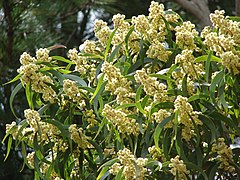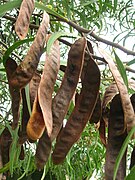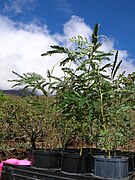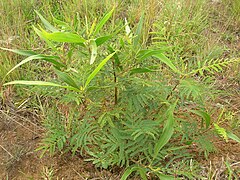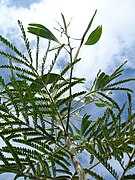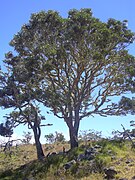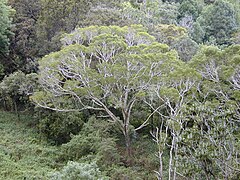Acacia koa
| Acacia koa | |
|---|---|
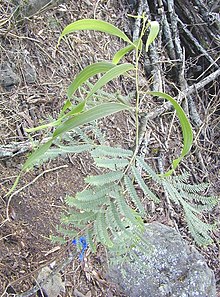
| |
| A young koa tree showing compound leaves and phyllodes | |
| Scientific classification | |
| Kingdom: | Plantae |
| Clade: | Tracheophytes |
| Clade: | Angiosperms |
| Clade: | Eudicots |
| Clade: | Rosids |
| Order: | Fabales |
| Family: | Fabaceae |
| Subfamily: | Caesalpinioideae |
| Clade: | Mimosoid clade |
| Genus: | Acacia |
| Species: | A. koa
|
| Binomial name | |
| Acacia koa | |
| Synonyms[2] | |
|
Acacia heterophylla var. latifolia Benth. | |
Acacia koa, commonly known as koa,[3] is a species of flowering tree in the family Fabaceae. It is endemic to the Hawaiian Islands,[2] where it is the second most common tree.[4] The highest populations are on Hawaiʻi, Maui and Oʻahu.
Name
The name koa in the
Koa also means brave, bold, fearless, or warrior.[3]
Description

Koa is a large tree, typically attaining a height of 15–25 m (49–82 ft) and a spread of 6–12 m (20–39 ft).[6] In deep volcanic ash, a koa tree can reach a height of 30 m (98 ft), a circumference of 6 m (20 ft), and a spread of 38 m (125 ft).[7] It is one of the fastest-growing Hawaiian trees, capable of reaching 6–9 m (20–30 ft) in five years on a good site.[8]
Leaves
Initially, bipinnately compound leaves with 12–24 pairs of leaflets grow on the koa plant, much like other members of the pea family. At about 6–9 months of age, however, thick sickle-shaped "leaves" that are not compound begin to grow. These are phyllodes, blades that develop as an expansion of the leaf petiole. The vertically flattened orientation of the phyllodes allows sunlight to pass to lower levels of the tree. True leaves are entirely replaced by 7–25 cm (2.8–9.8 in) long, 0.5–2.5 cm (0.20–0.98 in) wide phyllodes on an adult tree.[6]
Flowers
Flowers of the koa tree are pale-yellow spherical racemes with a diameter of 8–10 mm (0.31–0.39 in).[9] Flowering may be seasonal or year round depending on the location.[6]
Fruit
Fruit production start occurring when a koa tree is between 5 and 30 years old. The fruit are legumes, also called pods, with a length of 7.5–15 cm (3.0–5.9 in) and a width of 1.5–2.5 cm (0.59–0.98 in). Each pod contains an average of 12 seeds. The 6–12 mm (0.24–0.47 in) long, 4–7 mm (0.16–0.28 in) wide seeds are flattened ellipsoids and range from dark brown to black in color. The pods are mature and ready for propagation after turning from green to brown or black. Seeds are covered with a hard seed coat, and this allows them to remain dormant for up to 25 years. Scarification is needed before A. koa seeds will germinate.[9]
Habitat
Koa is
Uses

The koa's trunk was used by
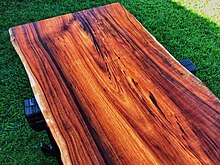
Taylor, Collings and Martin are few among the many other brands that use that tonewood for manufacturing acoustic guitars. [22]
Relation to other species
A closely related species, koaiʻa or koaiʻe (A. koaia), is found in dry areas. It is most easily distinguished by having smaller seeds that are arranged end-to-end in the pod, rather than side by side. The phyllodes are also usually straighter, though this character is variable in both species. The wood is denser, harder, and more finely grained than koa wood.[6] Koaiʻa has been much more heavily impacted by cattle and is now rare, but can be seen on ranch land in North Kohala.[citation needed]
Conservation
The koa population has suffered from grazing and
Ecology
Koa is the preferred
Gallery
This section contains an unencyclopedic or excessive gallery of images. |
-
Acacia koa with phyllode between the branch and the compound leaves
References
- ^ Contu, S. 2012. Acacia koa. The IUCN Red List of Threatened Species 2012: e.T19891713A19999145. https://dx.doi.org/10.2305/IUCN.UK.2012.RLTS.T19891713A19999145.en. Downloaded 8 May 2017.
- ^ a b "Acacia koa". Germplasm Resources Information Network. Agricultural Research Service, United States Department of Agriculture. Retrieved 2010-05-03.
- ^ ISBN 978-0-8248-1994-1.
- ^ University of Hawaiʻi at Mānoa. Retrieved 2009-01-31.
- ^ Blust, Robert; Trussel, Stephen (2010). "*teRas: heartwood of a tree, hard, durable core of wood; ironwood tree". Austronesian Comparative Dictionary. Max Planck Institute for Evolutionary Anthropology. Retrieved 27 December 2022.
- ^ a b c d e f g Elevitch, Craig R.; Kim M. Wilkinson; J. B. Friday; C. Baron Porter (April 2006). "Acacia koa (koa) and Acacia koaia (koaiʻa)" (PDF). The Traditional Tree Initiative.
{{cite journal}}: Cite journal requires|journal=(help) - ISBN 978-0-8225-4685-6.
- ISBN 978-0-9702544-2-9.
- ^ a b c Allen, James A. (2003-01-01). "Acacia koa A. Gray" (PDF). Tropical Tree Seed Manual. Reforestation, Nurseries & Genetics Resources. Retrieved 2009-02-23.
- ^ a b Whitesell, Craig D (1990). "Acacia koa". In Burns, Russell M.; Honkala, Barbara H. (eds.). Hardwoods. Silvics of North America. Vol. 2. Washington, D.C.: United States Forest Service (USFS), United States Department of Agriculture (USDA). Archived from the original on 20 January 2009. Retrieved 2009-02-17 – via Southern Research Station.
- ISBN 978-0-8248-2190-6.
- ISBN 978-0-8248-1096-2.
- ISBN 978-1-4446-7820-8.
- ISBN 978-0-7603-2753-1.
- ^ Beberman, Norman L. "Koa: Beautiful Looking, Beautiful Sounding Tonewood". GuitarNation.com. Archived from the original on 7 February 2009. Retrieved 2009-02-23.
- ISBN 978-3-8024-0446-7.
- ISBN 978-1-890490-21-8.
- ISBN 978-0-8264-6322-7.
- ISBN 978-0-933224-18-6.
- ^ Kirkland, Eric (December 2006). "Rich and Famous". Guitar World: 154.
- ^ "Silviculture: Diversification of Rural Economy". Leeward Haleakalā Watershed Restoration Partnership. Retrieved 2009-02-01.
- ^ "Is Koa Wood The Ultimate Choice For Guitar Enthusiasts?". Best Guitars Now. Retrieved 2023-11-24.
- United States Forestry Service.)
{{cite journal}}: Cite journal requires|journal=(help - PMID 24943937.
- ^ PMID 24942529.
- ^ Friday, J. B.; Darrell A. Herbert (April 2006). "Metrosideros polymorpha ('ōhi'a lehua)" (PDF). The Traditional Tree Initiative: 21.
{{cite journal}}: Cite journal requires|journal=(help) - ISBN 978-0-8047-2013-7.
- ISBN 978-0-935848-93-9.
- ^ "Koa Bug Investigation" (PDF). Uhh.hawaii.edu. Retrieved 15 March 2022.
External links
 Media related to Acacia koa at Wikimedia Commons
Media related to Acacia koa at Wikimedia Commons Data related to Acacia koa at Wikispecies
Data related to Acacia koa at Wikispecies- Photos of Acacia koa at Hawaiian Ecosystems at Risk Project (HEAR)
- UCLA botanical garden and home
- Historic photos and descriptions of Acacia koa


